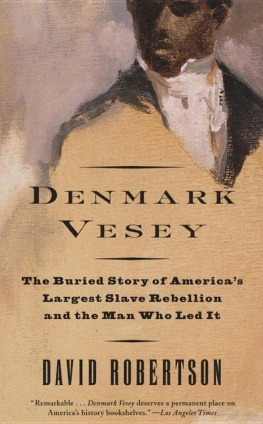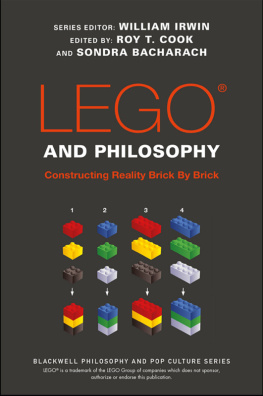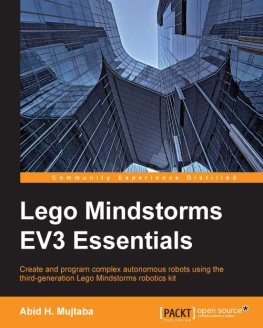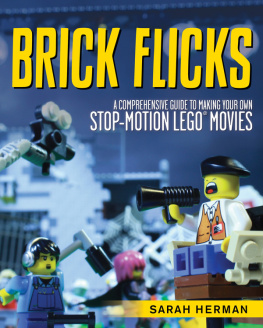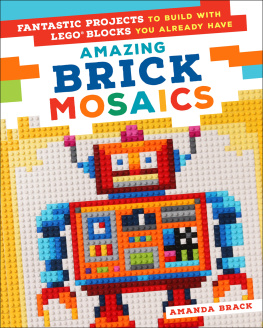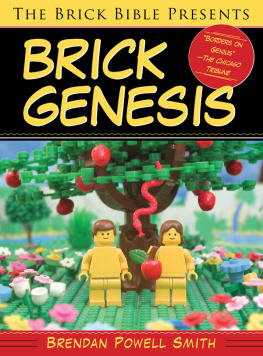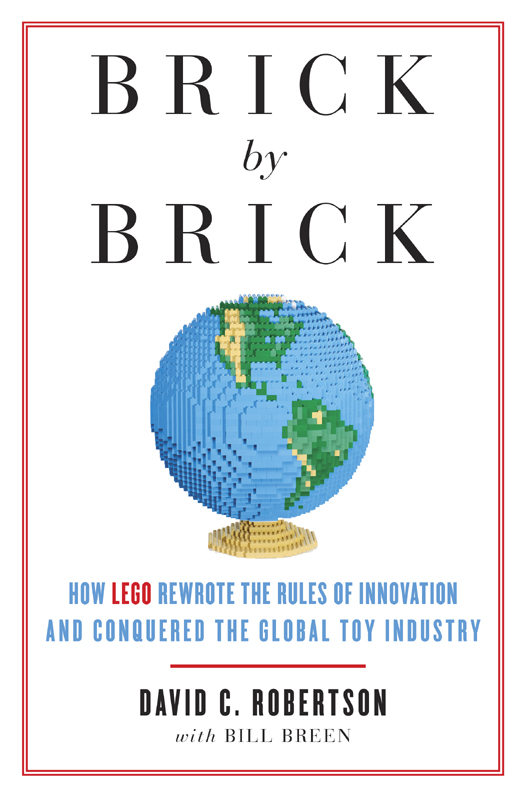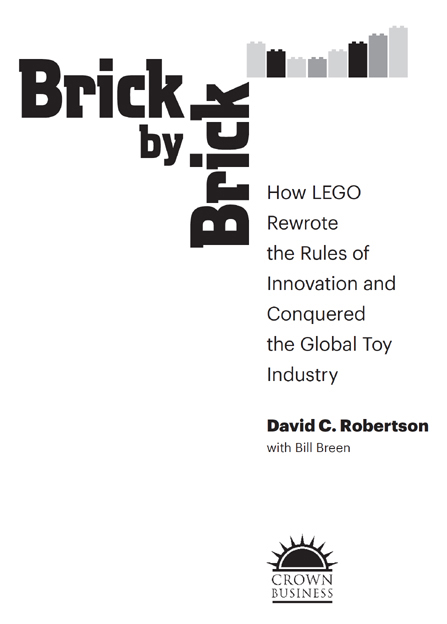Copyright 2013 by David C. Robertson
All rights reserved.
Published in the United States by Crown Business, an imprint of the Crown Publishing Group, a division of Random House, Inc., New York.
www.crownpublishing.com
CROWN BUSINESS is a trademark and Crown and the Rising Sun colophon are registered trademarks of Random House, Inc.
LEGO, the LEGO logo, the Minifigure, DUPLO, Bionicle, Galidor, Ninjago, Fabuland, and LEGOLAND are trademarks of the LEGO Group. Copyright 2013 the LEGO Group. www.LEGO.com.
Star Wars copyright 2013 Lucasfilms Ltd & TM. All rights reserved. Used under authorization.
Photos on is courtesy of Adam Reed Tucker.
Insert photos are courtesy of the author.
Library of Congress Cataloging-in-Publication Data
Robertson, David C. (David Chandler)
Brick by brick / David C. Robertson with Bill Breen.First edition.
pages cm
1. LEGO koncernen (Denmark) 2. Toy industryDenmarkManagement.
3. LEGO toysHistory. I. Breen, Bill. II. Title.
HD9993.T694L447 2013
338.7688725dc23 2013004798
eISBN: 978-0-307-95162-5
Jacket design by Michael Nagin
LEGO artist: Nathan Sawaya
Jacket photographs: Frank Longhitano
v3.1
To Gordon and Caroline,
from whom I learned the most
important lessons about LEGO
DCR
Contents
Introduction
When the Bricks Click
PART ONE
The Seven Truths of Innovation and the LEGO Groups Decline
CHAPTER 1
Stacking Up
The Birth of the Brick
CHAPTER 2
Boosting Innovation
The LEGO Groups Bold Bid to Keep Pace with a Fast-Forward World
CHAPTER 3
Losing Control
The Scattered Remains of Runaway Innovation
PART TWO
Mastering the Seven Truths of Innovation and Transforming LEGO
CHAPTER 4
Building an Innovation Culture
The Return to Core Values
CHAPTER 5
Becoming Customer Driven
The Rebirth of LEGO City
CHAPTER 6
Exploring the Full Spectrum of Innovation
The Bionicle Chronicle
CHAPTER 7
Fostering Open Innovation
Mindstorms, Architecture, and the Wisdom of the Clique
CHAPTER 8
Attempting a Disruptive Innovation
Aiming for the Stars with LEGO Universe
CHAPTER 9
Sailing for Blue Ocean
Obviously LEGO, but Never Seen Before and the Birth of LEGO Games
CHAPTER 10
Leveraging Diverse and Creative People
The Ninjago Big Bang
CHAPTER 11
Transforming LEGO
The Rebirth of a Brand
Preface
I first approached the LEGO Group in 2007 while studying innovation efforts at companies in the United States and Europe. Id surveyed fifty-six companies to understand their innovation management practices and planned to write a book about innovation and leadership, where Id draw lessons and stories from many organizations and use those cases to illustrate how companies should manage innovation. After visiting LEGO, I wrote a case study that I hoped to use both in the classroom at the Swiss business school IMD and, later, in my book.
When I first taught my case study of LEGO at IMD in 2008 and 2009, I was taken aback by the outpouring of enthusiasm for the brand and its capacity to reawaken the sense of experimentation and play that resides within everyone. Subsequent interviews uncovered one fascinating aspect of the LEGO story after another. I realized that the LEGO management team had done more than just turn around the company; they had fundamentally rethought what innovation meant and how it should be managed and, by doing so, had rescued the company and boosted its performance to new heights. I saw that this case study was much more than a chapter in a book about innovation managementit was a full books worth of stories and lessons: about a toy that touched the lives of millions around the globe for close to a century; about a much-beloved company that lost touch with its customers and its history and almost went out of business as a result; and about managers whose love for the company and perseverance saved it from ruin. What started as an academic book about innovation management became a much richer narrative of failure and recovery.
Since 2008 Ive made more than a dozen trips to LEGO headquarters in Billund, Denmark (I highly recommend a June visit over one in January), where Ive interviewed dozens of senior managers; sat in the bright white rooms of the Idea House and heard designers describe how they dream up new toys; pored over sketches and computer-generated designs that traced the evolution of some of the companys most compelling kits; visited the sprawling, noisy factories where millions of tons of plastic are molded into billions of bricks; and had a memorable meeting with Kjeld Kirk Kristiansen, a grandson of the companys founder and its chief executive for twenty-five years.
My trip around LEGO world also took me to FIRST LEGO League competitions in the United States and Switzerland, where I watched my sons teams compete against hundreds of other kids in frenzied robotics tournaments. In Fort Lee, New Jersey, I followed a team of LEGO designers and anthropologists as they tested their ideas for the next generation of kits with the worlds most fickle, demanding consumersnine- and ten-year-old boys. In a suburb of Chicago, Illinois, I met Adam Reed Tucker, who not only built a replica of architect Frank Lloyd Wrights iconic Fallingwater house entirely out of bricks, but transformed the replica into a kit and commercialized it through LEGO. In West Lafayette, Indiana, I met Steve Hassenplug, one of the greatest Mindstorms builders on the planet. And I traveled to Boulder, Colorado, where I met with some of the best game programmers and designers in the United States, who turned millions of lines of software code into the virtual worlds that constituted LEGO Universe.
At every turn, the companys leaders, employees, partners, and fans were remarkably candid about the mistakes that fueled its downfall, as well as the false starts and dead ends that accompanied its turnaround. Over its eighty-plus years, and particularly during the past decade, the LEGO Group has proven itself to be as resilient as its virtually indestructible bricks and as resourceful as the nine-year-olds who bring them to life.
Along the way I met dozens of LEGO employees, partners, and fans who were consistently friendly, smart, thoughtful, and generous with their time. I would like to thank Henrik Weis Aalbaek, Henrik Andersen, Tormod Askildsen, Phil Atencio, Erich Bach, Zev Barsky, Jamie Berard, Torsten Bjorn, Karsten Juel Bunch, Steve Canvin, Dan Elggren, Peter Espersen, Greg Farshtey, Helle Friberg, Ulrik Gernow, John Hansen, Mark Hansen, Lena Dixon Hjoland, Sren Holm, Cephas Howard, Niels Sandahl Jakobsen, Birthe Jensen, Jacob Kragh, Kjeld Kirk Kristiansen, Jens Lambak, Allan Steen Larsen, Kim Yde Larson, Soren Torp Laursen, Erik Legernes, Henrik Taudorf Lorenzen, Sren Lund, Phil McCormick, Sine Moller, Jai Mukherjee, Gitte Nipper, Mads Nipper, Henrik Nonnemann, Lars Nyengaard, Jette Orduna, Fleming stergaard, Lisbeth Pallesen, Niels Milan Pedersen, Christoffer Raundahl, Jan Ryan, John Sahlertz, Ronny Scherer, Poul Schou, Chris Sherland, Mark Stafford, Robert Stecher, Bjarne Tveskov, and Jill Wilfort from LEGO; Jesper Ovesen and Henrik Poulsen from TDC; Howard Roffman from Lucasfilm; Mitch Resnick from the MIT Media Lab; Jonathan Smith and Tom Stone from TT Games; Christian Faber from Advance; Scott Brown, Peter Grundy, and Ryan Seabury from NetDevil; and Peter Eio, Steve Hassenplug, Bill Hoover, Jake McKee, Megan Nerz, Poul Plougmann, Robert Rasmussen, Megan Rothrock, and Adam Reed Tucker.


